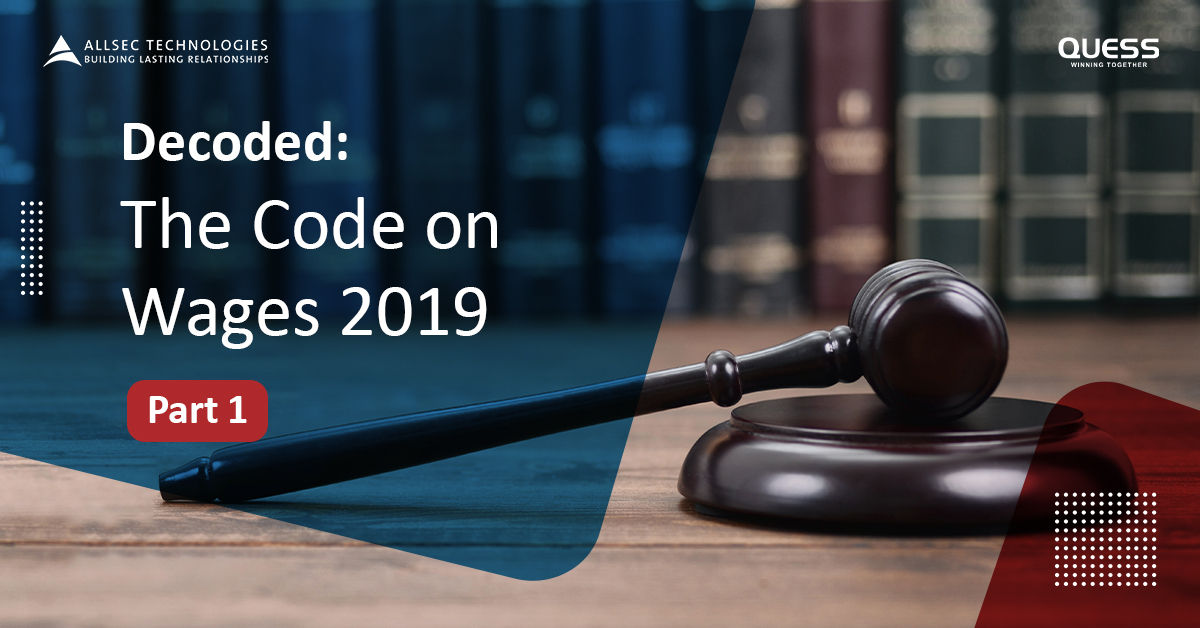
Decoded: The Code on Wages 2019 (Part 1)
Key definitions the ‘Wage Code’ will alter.
The Code on wages aims to “amalgamate, simplify and rationalize” compliance management for employers. It can also make payroll processing less cumbersome as it clubs the Payment of Wages Act, 1936; Minimum Wages Act, 1948; Payment of Bonus Act, 1965; and Equal Remuneration Act, 1976 into a single code. Employers now have to tackle only 69 sections and nine chapters, rather than 123 sections from four different acts.
It is expected that the Code will be brought into force in the next financial year. In the first part of Decoded, we will look at three key definitions the Wage Code will alter:
Wages
The law clubs basic pay, dearness allowance, and retaining allowance under the term “wages.” According to Section 2(y) of the code, a wage will mean all remunerations whether it is salary, allowance, or otherwise, that can be expressed in terms of money payable to a person for fulfilling the term of employment.
It specifically excludes statutory bonus, conveyance allowance, house rent allowance, and overtime allowance. Retrenchment compensation, retirement benefits or any ex gratia payment made to the employee will no longer be called wages. However, the specified exclusions should not exceed 50% of the total remuneration.
Key takeaways
The new definition may reduce litigation and compliance costs for employers. Earlier, wages had 12 definitions in different labor laws resulting in litigation in many cases. At a cursory glance, the single definition seems to be a countermeasure.
However, it may complicate bonus-calculation and commissions. There is also the potential for wages to vary month-on-month. A PF Law amendment has been proposed to replicate the same wage definition in the PF Act to address these issues.
Floor and Minimum Wages
Floor wages will now be fixed by the central government and minimum wages by the state government, for both the organized and unorganized sectors. While fixing the wage, authorities will now take into account the living conditions of the workers.
The act also allows state governments to tweak floor wages based on geographical location. However, the minimum wage should be higher than the floor wage of the region. It is also mandatory for minimum overtime wages to not be less than double the normal remuneration. Revision or review of the minimum wages is to occur within five-year intervals.
Key takeaways
Employers need to be more vigilant of the minimum wages they assign. The code is vague on the caps based on employee hierarchy. It does not address how organizations should decide the minimum wage of employees based on stature or designation. However, the minimum bonus is clearly specified. It is 8.33 percent of the present wage and the maximum is 20 percent.
‘Employee’, ‘Employers’ and ‘Workers’
The code has added ‘contractors’ to the definition of employers. According to it, anyone who undertakes a project to deliver a result through contract labor or one who supplies contract labor will be called a contractor. They are subject to all the laws and regulations which an employer must follow.
Regarding ‘employer’ and ‘workers’, the code provides two separate definitions. It places individuals in the managerial and supervisory roles in the employee bucket but excludes them from those of workers. Sales professionals and journalists are specifically stated to be employees, not workers. However, close examination shows that the definition of workers can be interpreted as a subset of the definition of employees.
Key takeaways
Confusion regarding who is an employee and a worker is likely to continue. The overlapping nature of the definitions leaves a lot of grey areas for employers to figure out. To eschew non-compliance, a clear demarcation within the organization is crucial.
Summary
Employers need to acquaint themselves with the revised definitions. Expert consultation is advised on how the new code will impact operations. The definition of ‘’basic wages” in the Employees’ Provident Funds and Miscellaneous Provisions Act, 1952 (the EPF Act) is also likely to change. The analysis should, therefore, include a study from the PF perspective of statutory compliance.
In the next part…
An analysis of how the code on wages will impact payment of wages.
Read Part 2
Alldigi provides end-to-end comprehensive HR management solutions including consultations by leading industrial experts on compliance management. Reach out to us for more information.



